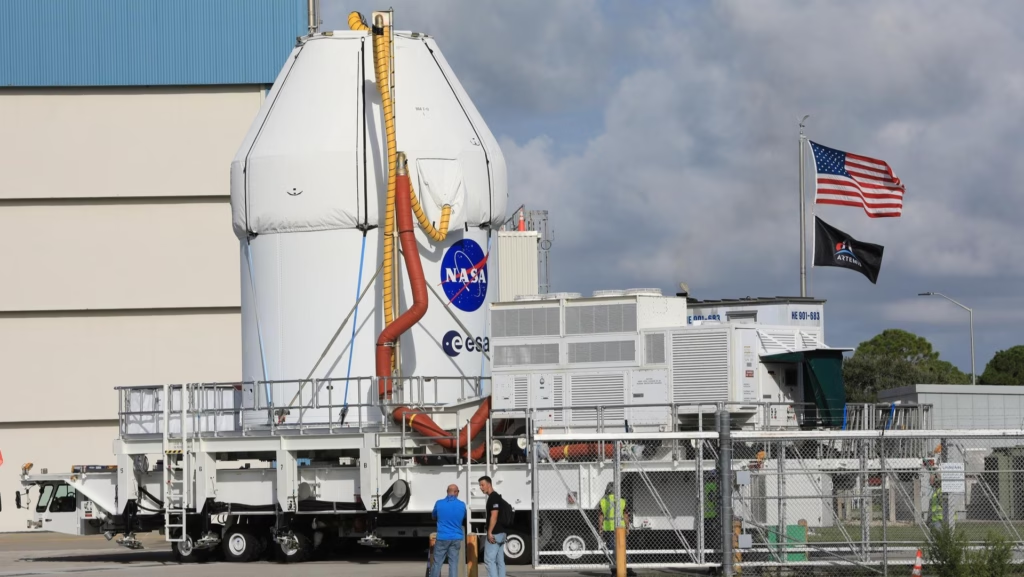
If everything goes as planned, April 2026 will mark a historic moment for space exploration. From NASA’s Kennedy Space Center in Florida, a massive Space Launch System (SLS) rocket will rise into the sky from Launch Complex 39B. On top of it will be the Orion spacecraft, carrying four astronauts on a mission unlike any other.
This will be the first time humans are sent to the Moon under NASA’s Artemis program, a project years in the making and backed by billions of dollars. It’s a mission designed not just to revisit our lunar neighbor but to pave the way for a whole new chapter in human exploration. And even though the launch is still months away, preparations are moving faster than you might imagine.
You can feel the momentum building, especially when you see how quickly the Orion spacecraft, the astronauts’ home for the mission is coming together.
Getting Orion Ready for the Big Journey
Back in May, the Orion spacecraft arrived at NASA’s Multi-Payload Processing Facility (MPPF). This is where engineers prepared it for the extreme environment of space. They filled it with the vital supplies it needs, including propellants, high-pressure gases, coolant, and other fluids that will keep it functioning during the journey.
While Orion was being prepared, the Artemis II crew had their own hands-on experiences with the spacecraft. NASA astronauts Reid Wiseman, Victor Glover, Christina Koch, and Canadian Space Agency astronaut Jeremy Hansen all took part in tests.
They climbed aboard multiple times, even wearing their Orion Crew Survival System spacesuits, to get used to the cramped quarters and the equipment they’ll rely on. These practice sessions were more than just photo opportunities, they were essential for making sure the astronauts feel comfortable and prepared for their mission.
Adding the Launch Abort System
Recently, Orion was moved to NASA’s Launch Abort System Facility (LASF). Here, engineers will install a vital piece of safety technology: the Launch Abort System (LAS).
This towering 44-foot (13-meter) structure sits on top of the spacecraft and is designed to pull the crew to safety if something goes wrong during launch. It has two main parts. The first is the launch abort tower, which houses the motors that can quickly push the capsule away from danger.
The second is the fairing assembly, which includes the aerodynamic panels that protect the crew module and keep the rocket stable during liftoff. Nobody wants to see the abort system actually used, but everyone agrees it’s essential. In the rare event of a launch emergency, it could save the astronauts’ lives.
Practicing for the Worst-Case Scenario
NASA isn’t leaving anything to chance. Earlier this year, they ran a series of rescue drills off the coast of Florida with help from the U.S. Navy and U.S. Air Force.
In June, they simulated two possible emergencies. The first was a problem on the launch pad before liftoff. The second, even more dangerous, was an abort during the rocket’s climb into space.
These rehearsals covered every step of getting the crew to safety and transporting them to a secure location. It’s a reminder that space travel is still risky business, and preparation is everything.
What’s Next for Orion
Once the Launch Abort System is attached, Orion’s next stop will be High Bay 3 inside the Vehicle Assembly Building (VAB). This is where the spacecraft will finally meet its ride to the Moon—the powerful SLS rocket.
This will be one of the final steps before the entire assembly is rolled out to the launch pad for its big day. From there, the countdown to liftoff will truly begin.
Why Artemis II Matters
The Artemis II mission is more than just a test flight. If successful, it will open the door to exploring the Moon in ways we’ve never done before. NASA’s long-term plan involves building spacecraft, rovers, and even a lunar space station to support future missions.
And the Moon is just the start. By using it as a stepping stone, NASA hopes to prepare for eventual human missions to Mars.
NASA Mission Plan
Even though Artemis II won’t land on the Moon, it will still be a record-breaking journey. The four astronauts will spend about ten days in space. They’ll spend the first two days orbiting Earth before heading out on a trajectory that will carry them farther than any human has ever traveled.
Orion will travel about 230,000 miles (370,000 kilometers) from Earth, passing more than 6,000 miles (10,000 kilometers) beyond the Moon before heading back. This deep-space path will allow NASA to test every system on Orion under real mission conditions.
A Look Ahead to Artemis III
If Artemis II goes as planned, the next step will be Artemis III, scheduled about a year later. That mission will put humans back on the Moon for the first time in over 50 years. The crew for that mission hasn’t been announced yet, but whoever is chosen will take part in a moment that will define a generation.
With Artemis, we are looking at a future where humans live and work on the Moon, not just visit it. It’s a bold vision, but each milestone—like the Artemis II mission—brings it closer to reality.
A Historic Moment Awaits
In just a short time, four astronauts will strap into Orion and blast off toward the Moon. They’ll see our planet from hundreds of thousands of miles away, test the limits of new technology, and bring humanity one step closer to becoming a multi-planet species.
The Artemis II mission is more than just a flight, it’s the start of a new chapter in human history. And when the rocket lifts off in April 2026, the world will be watching.
Source: NASA

